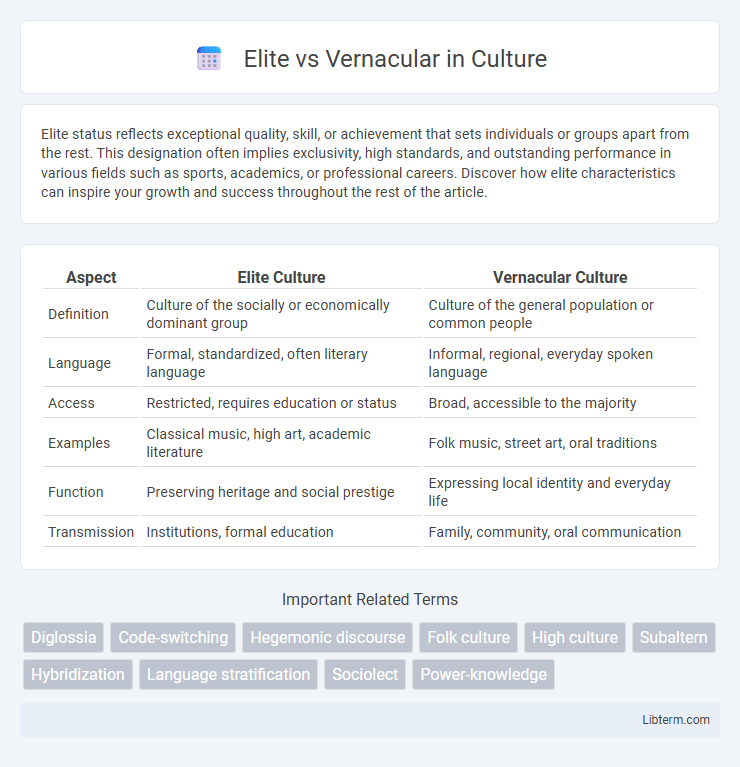Elite status reflects exceptional quality, skill, or achievement that sets individuals or groups apart from the rest. This designation often implies exclusivity, high standards, and outstanding performance in various fields such as sports, academics, or professional careers. Discover how elite characteristics can inspire your growth and success throughout the rest of the article.
Table of Comparison
| Aspect | Elite Culture | Vernacular Culture |
|---|---|---|
| Definition | Culture of the socially or economically dominant group | Culture of the general population or common people |
| Language | Formal, standardized, often literary language | Informal, regional, everyday spoken language |
| Access | Restricted, requires education or status | Broad, accessible to the majority |
| Examples | Classical music, high art, academic literature | Folk music, street art, oral traditions |
| Function | Preserving heritage and social prestige | Expressing local identity and everyday life |
| Transmission | Institutions, formal education | Family, community, oral communication |
Defining Elite and Vernacular
Elite language represents the formal, standardized mode of communication used by educated and influential groups, often associated with authority, literature, and official discourse. Vernacular refers to the everyday speech of ordinary people within a specific region or community, characterized by informal, local, and culturally expressive forms. Understanding the distinction between elite and vernacular languages highlights the social dynamics influencing language use, identity, and power structures.
Historical Context of Elite and Vernacular Divides
The historical context of elite and vernacular divides dates back to medieval Europe when Latin dominated as the language of scholarship, law, and governance, privileging elite communication. Vernacular languages, spoken by common people, gradually gained literary and administrative significance during the Renaissance and Reformation, challenging the exclusive status of Latin. This linguistic shift facilitated broader cultural participation and national identity formation by bridging elite and popular discourse.
Linguistic Features: Elite vs Vernacular
Elite language varieties exhibit complex syntactic structures and extensive vocabulary influenced by formal education and literary traditions, while vernacular varieties often feature simpler grammar and phonological patterns shaped by daily spoken interaction and regional identity. Morphological markers in elite language forms tend to follow standardized norms, contrasting with the vernacular's frequent use of colloquial contractions and dialect-specific expressions. Pragmatic usage in elite speech emphasizes politeness strategies and formality, whereas vernacular communication relies more on contextual cues and informal, community-based norms.
Social Implications of Language Choices
Language choices between elite and vernacular varieties shape social identity and influence power dynamics within communities. Elite language often grants access to institutional resources, educational opportunities, and higher socioeconomic status, while vernacular languages preserve cultural heritage and foster social cohesion among local groups. This linguistic divide can reinforce social stratification, affecting individuals' mobility and societal participation.
Education and Language Hierarchies
Elite languages in education often dominate curricula and standardized tests, reinforcing social stratification by privileging dominant cultural groups. Vernacular languages, typically spoken by marginalized communities, face systematic exclusion, limiting access to quality education and perpetuating language hierarchies. This linguistic disparity impacts cognitive development and social mobility, highlighting the need for inclusive language policies that value multilingualism in educational systems.
Cultural Identity and Vernacular Expression
Elite languages often symbolize cultural identity tied to formal education, governance, and historical prestige, reinforcing societal hierarchies and national identities. Vernacular expressions embody the lived experiences, traditions, and values of local communities, fostering intimate connections to heritage and cultural authenticity. The dynamic interplay between elite and vernacular forms shapes collective identity by preserving cultural diversity while influencing language evolution and social integration.
Media Representation: Whose Voice Prevails?
Elite media often dominate public discourse by shaping narratives through established institutions, resulting in widespread influence over political and cultural issues. Vernacular media, rooted in local languages and communities, provides alternative perspectives that challenge mainstream portrayals and amplify marginalized voices. The prevailing voice in media representation depends on power dynamics, access to resources, and audience reach, with elite media typically controlling dominant narratives while vernacular media fosters grassroots engagement and diverse viewpoints.
Power Dynamics in Language Standardization
Elite and vernacular languages reflect significant power dynamics in language standardization, where elite languages often dominate official, educational, and media spheres, reinforcing social hierarchies. Vernacular languages face marginalization as they lack institutional support, impacting cultural identity and access to resources. This imbalance perpetuates linguistic inequality and influences policies favoring elite language preservation and propagation.
Vernacular Resilience: Resistance and Adaptation
Vernacular resilience embodies the capacity of local languages and dialects to resist homogenization and adapt to changing sociocultural landscapes, preserving unique cultural identities despite dominant elite influences. This resilience is manifested through continuous oral traditions, innovative lexical borrowings, and community-driven preservation efforts that reinforce vernacular vitality. By sustaining everyday communication and cultural practices, vernacular languages maintain their relevance and function as a form of cultural resistance in the face of globalization and standardized elite languages.
Bridging the Gap: Towards Linguistic Inclusivity
Bridging the gap between elite and vernacular languages fosters linguistic inclusivity by promoting equal access to education, media, and public services. Emphasizing the legitimacy and functionality of vernacular languages challenges hierarchical language ideologies while enhancing cultural diversity and social cohesion. Integrating both language forms in policy frameworks and communication strategies empowers marginalized communities and supports sustainable development.
Elite Infographic

 libterm.com
libterm.com